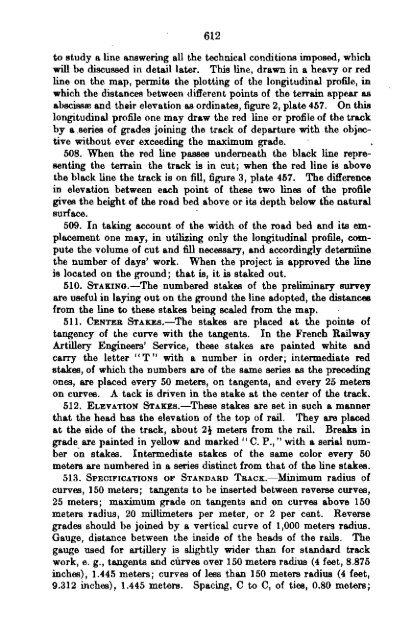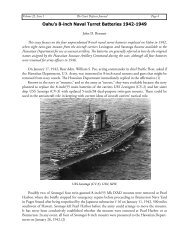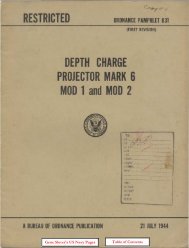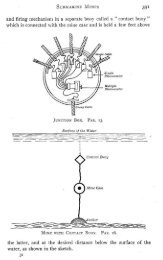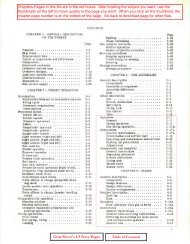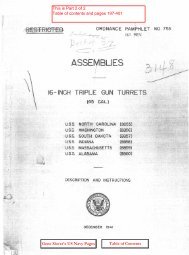...Railway artillery - Personal Page of GENE SLOVER
...Railway artillery - Personal Page of GENE SLOVER
...Railway artillery - Personal Page of GENE SLOVER
You also want an ePaper? Increase the reach of your titles
YUMPU automatically turns print PDFs into web optimized ePapers that Google loves.
612<br />
to study a line answering all the technical conditions imposed, which<br />
will be discussed in detail later. This line, drawn in a heavy or red<br />
line on the map, permits the plotting <strong>of</strong> the longitudinal pr<strong>of</strong>ile, in<br />
which the distances between different points <strong>of</strong> the terrain appear as<br />
abseissre and their elevation as ordinates, figure 2, plate 457. On this<br />
longitudinal pr<strong>of</strong>ile one may draw the red line or pr<strong>of</strong>ile <strong>of</strong> the track<br />
by ... series <strong>of</strong> grades joining the track <strong>of</strong> departure with the objective<br />
without ever exceeding the maximum grade.<br />
508. When the red line passes underneath the black line representing<br />
the terrain the track is in cut; when the red line is above<br />
the black line the track is on fill, figure 3, plate 457. The difference<br />
in elevation between each point <strong>of</strong> these two lines <strong>of</strong> the pr<strong>of</strong>ile<br />
gives the height <strong>of</strong> the road bed above or its depth below tlie natural<br />
surface. .<br />
509; In taking account <strong>of</strong> the width <strong>of</strong> the road bed and its emplacement<br />
one may, in utilizing only the longitudinal pr<strong>of</strong>ile, compute<br />
the volume <strong>of</strong> cut and fill necessary, and accordingly determine<br />
the number <strong>of</strong> days' work. When the project is approved the line<br />
is located on the ground; that is, it is staked out.<br />
510. STAKING.-The numbered stakes <strong>of</strong> the preliminary survey<br />
are useful in laying out on the ground the line adopted, the distances<br />
from ihe line to these stakes being scaled from the map.<br />
511. CENTER STAKEs.-The stakes are placed at the points <strong>of</strong><br />
tangency <strong>of</strong> the curve with the tangents. In the French <strong>Railway</strong><br />
Artillery Engineers' Service, these stakes are painted white and<br />
carry the letter /I T" with a number in order; intermediate red<br />
stakes, <strong>of</strong> which the numbers are <strong>of</strong> the same series as the preceding<br />
ones, are placed every 50 meters, on tangents, and every 25 meters<br />
on curves. A tack is driven in the stake at the center <strong>of</strong> the track.<br />
512. ELEVATION STAKEs.-These stakes are set in such a manner<br />
that the head has the elevation <strong>of</strong> the top <strong>of</strong> rail. They are placed<br />
at the side <strong>of</strong> the track, about 21 meters from the rail. Breaks in<br />
grade are painted in yellow and marked /I C. P.," with a serial number<br />
on stakes. Intermediate stakes <strong>of</strong> the same color every 50<br />
meters are numbered in a series distinct from that <strong>of</strong> the line stakes.<br />
513. SPECIFICATIONS OF STANDARD TRACK.-Minimum radius <strong>of</strong><br />
curves, 150 meters; tangents to be inserted between reverse curves,<br />
25 meters; maximum grade on tangents and on curves above 150<br />
meters radius, 20 millimeters per meter, or 2 per cent. Reverse<br />
grades should be joined by a vertical curve <strong>of</strong> 1,000 meters radius.<br />
Gauge, distance between the inside <strong>of</strong> the heads <strong>of</strong> the rails. The<br />
gauge used for <strong>artillery</strong> is slightly wider than for standard track<br />
work, e. g., tangents and curves over 150 meters radius (4 feet, 8.875<br />
inches), 1.445 meters; curves <strong>of</strong> less than 150 meters radius (4 feet,<br />
9.312 inches), 1.445 meters. Spacing, C to C, <strong>of</strong> ties, 0.80 meters;<br />
Digitized by Coogle


